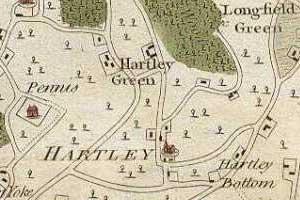Go To Section
Cheshire
County
Available from Boydell and Brewer
Background Information
Number of voters:
over 5,000
Elections
| Date | Candidate |
|---|---|
| 26 June 1790 | SIR ROBERT SALUSBURY COTTON, Bt. |
| JOHN CREWE | |
| 11 June 1796 | JOHN CREWE |
| THOMAS CHOLMONDELEY | |
| 16 July 1802 | THOMAS CHOLMONDELEY |
| WILLIAM EGERTON | |
| 22 May 1806 | DAVIES DAVENPORT vice Egerton, deceased |
| 18 Nov. 1806 | THOMAS CHOLMONDELEY |
| DAVIES DAVENPORT | |
| 15 May 1807 | THOMAS CHOLMONDELEY |
| DAVIES DAVENPORT | |
| 20 Oct. 1812 | DAVIES DAVENPORT |
| WILBRAHAM EGERTON | |
| 30 June 1818 | DAVIES DAVENPORT |
| WILBRAHAM EGERTON |
Main Article
The representation of Cheshire, uncontested between 1734 and 1832, remained the preserve of a few county families in this period. The richest of them, the Grosvenors of Eaton Hall, played little part, concentrating their attention on Chester.
It was rumoured in 1794 that the Whig John Crewe would ‘probably be turned out of Cheshire at the next election’, but nothing came of this in 1796 when his colleague Sir Robert Salusbury Cotton, a ministerialist, made a late announcement of his retirement, which seems to have been precipitated by peevishness at ‘being refused some little place he had asked for’. Lord Grey, son of the lord lieutenant, the 5th Earl of Stamford, and nephew of the 3rd Duke of Portland, showed an interest, as did John Delves Broughton, eldest son of Sir Thomas Broughton of Doddington, claiming to be ‘a friend to what he calls the Portland interest’. Neither got anywhere and the seat went to Thomas Cholmondeley of Vale Royal, Pitt’s second cousin, whose father and grandfather had represented the county and who was interested in the same item of local patronage for which Cotton applied in vain to Pitt. Lady Kenyon was told that Earl Grosvenor ‘encouraged Cholmondeley to stand for the county, for fear he should be troublesome to him in the city’. On the hustings Sir Thomas Broughton supported both candidates with ‘a long harangue which was chiefly directed against the election of the sons of peers’.1 When Crewe retired in 1802 he was replaced by the Pittite William Egerton of Tatton Park, who was in turn succeeded on his death in 1806 by Davies Davenport of Capesthorne, an independent, after John Broughton and Thomas Parker of Astle had declined on a show of hands at the county meeting.2
Charles Williams Wynn* told his uncle, 25 Aug. 1806, that Broughton had ‘declared his intention of opposing Cholmondeley for Cheshire’, but that there was a feeling that if he did so the Whig Sir Richard Brooke of Norton Priory, who had just come of age, ‘might probably step in and carry away the prize from them both, as from different circumstances they have each rendered themselves extremely unpopular’.3 Nothing came of this speculation. In July 1812 Wilbraham Egerton of Tatton, son of William, offered himself, in response to a requisition from ‘the principal gentlemen of Stockport’. (Sir) John Thomas Stanley* of Alderley told his mother, 23 July:
resolutions were passed at a respectable meeting at Macclesfield declaring that he ought to be supported, and that ‘during the whole time in which Mr Cholmondeley had been in Parliament, a marked inattention had been observed on his part to the duties which his high situation imposed on him’. Mr Davenport’s conduct was approved of in the resolutions. Egerton has been very active in canvassing the county and the disapprobation of Cholmondeley’s conduct has been so general that many have deserted him, I amongst the number, but Cholmondeley still retains strength enough to make him think he has a chance of being returned. So in all likelihood we shall have a regular contest.
Stanley added that he had been pressed to stand by ‘many of the respectable gentlemen at Macclesfield’, but had refused because his politics, as a moderate reformer, were ‘disapproved of by almost all our gentlemen’ and he had ‘not money enough to throw away in disputing their will’.4 The friends of Sir Robert Cotton’s son (Sir) Stapleton Cotton*, who had succeeded his father in 1809 and was on active service in the Peninsula, put his name forward, but Cotton, writing from Salamanca, 31 Aug. 1812, assured the Duke of Newcastle’s agent at Newark, his seat since 1806, that although in the unlikely event of his being returned for Cheshire free of ‘trouble or expense’ he ‘must submit’, he intended to stand again for Newark.5 Cholmondeley was thought to have every chance of success at Davenport’s expense, as of the leading landowners only Stamford, Crewe, Stanley and the Broughtons were actively hostile to him; but he eventually bowed to increasing pressure from his relatives to withdraw from what promised to be a financially ruinous contest. His bid for a peerage as a way out of his difficulties was unsuccessful.6 After the quiet election of 1818 it was remarked that ‘a mutual understanding’ existed ‘between the leading landed interests in the county’.7
Author: David R. Fisher
Notes
- 1. NLS mss 11138, f. 63; True Briton, 21 May; Kenyon mss, Arden to Kenyon [June 1796]; PRO 30/8/122, f. 241; 126, ff. 18-24; HMC Kenyon, 544; Heber Letters, 95.
- 2. Salopian Jnl. 30 Apr., 14 May 1806.
- 3. NLW mss 10804, Williams Wynn letter bks.
- 4. UCNW, Penrhos mss 518, 519.
- 5. Notts. RO, Smith Godfrey mss CP5/2/52.
- 6. NLW mss 2791, C. to H. Williams Wynn, 15 Aug. 1812; NLW, Aston Hall mss 2329, 2569, 2570, 7197; Add. 38328, f. 37; Geo. IV Letters, i. 147; Kenyon mss, Cholmondeley to Kenyon, 30 Sept. 1812.
- 7. The Late Elections (1818), 62.

